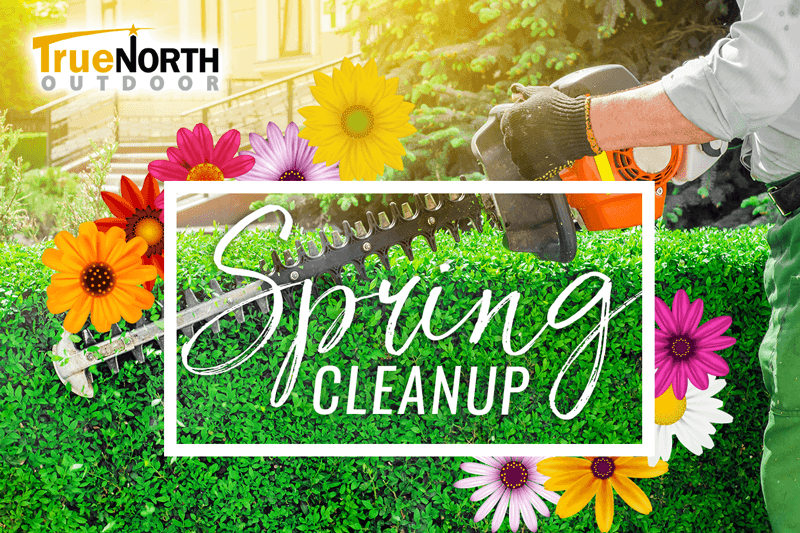SPRING CLEAN-UPS
Spring is two weeks away! Is your property ready?
Spring is less than two weeks away which means True North Outdoor is preparing to go out in full force for Spring Clean-ups on Kansas City commercial properties. These clean-ups help keep landscapes healthy; removing leaves, dead plants and making way for new growth. See the complete checklist for spring cleanups below.

At True North, we believe in proactive care, giving each property first class service and personal attention to detail. If you have not already, please make sure to schedule your preseason meeting with your client care specialist, so that we can review, plan and execute to meet your property’s goals.
These aren’t all of our services — just a few. In fact, whatever it takes to get your property looking its best, our team of lawn care and landscaping experts can take care of it! Speak with our spring clean-up crew about scheduling an appointment to get your property looking its seasonal best.
Clean up leaves, trash & debris
grass & perennial cutbacks
DEEP EDGE PLANTING BEDS AND TREE RINGS
apply pre-emergent herbicide
add fresh layer of mulch
Just as people speak of “spring cleaning” tasks performed to freshen up a home that has been shuttered up all winter, so lawns and the rest of your landscaping need some TLC at this time of year to prepare your property for the growing season.
A thorough spring yard cleanup readies your landscape for summer, but it can accomplish more than that, too. In some cases, it will save you from headaches farther down the road.
Cleanup leaves, trash, debris
In this first category of spring yard cleanup tasks, you will be picking up after Old Man Winter and any messy traffic you may have to put up with. We focus on:
- Litter and dog feces
- Dead grass, leaves, pinecones, etc. on lawns
- Dead leaves and stalks on perennials
Grass & Perennial Cutbacks
Now that winter’s over, it’s time to remove any shrub shelters protecting your bushes and size up their pruning needs. There are different reasons to remove wood from shrubs. If we’re talking about old, dead wood or wood recently damaged by winterkill, then the question is quite different in nature from when we’re discussing healthy wood.
Dead limbs and winterkill on branches should be pruned off. This is the easy part of pruning: Remember, you can’t go wrong pruning off something that’s already dead. And life and death are “color-coded” on trees and shrubs, just beneath their bark, with brown signaling death, green life. The key is determining where the brown ends and the green begins. Shrubs that bloom in spring have to have their buds already in place, on old wood (last year’s growth), so that they’re ready to kick into action when the warm weather comes; if you prune these branches off, you lose the flowers.
But shrubs that bloom later in the year don’t need that head start, blooming instead on new wood (growth produced in the current season).
Deep edge planting beds and tree rings
Spring cleanup in the perennial bed begins with removing any dead leaves and stalks from perennials and ornamental grasses that you didn’t remove in fall. In established perennial beds that performed well the prior year, working in some additional compost around your plants to fertilize them and make the soil more friable is the best thing that can be done.
While on the subject of compost, note that it’s not just for planting beds. Most all of your plants (including the grass in your lawn and your trees and shrubs) will enjoy a feeding of compost in the spring. The great thing about using compost as a fertilizer is that you never have to worry about burning plants with it. Compost is nature’s slow-release fertilizer.
Early spring is a good time to install trees and shrubs and to plant perennial flower borders, as long as they’re hardy perennials. For annuals and tender perennials, wait till the last frost date has passed for your region.
Apply Pre-Emergent Herbicide
It’s always easier to fight weeds before they even emerge, rather than waiting until they rear their ugly heads. Landscape fabric and mulch work well in garden beds, but you can’t use either on a lawn. That’s where preemergent herbicides come into play, particularly for crabgrass control.
Spring is the time to use a preemergent herbicide on crabgrass, and timing is of the essence. Crabgrass seed germinates when the soil temperature reaches 55 to 60 degrees F. You need to apply the preemergent herbicide prior to this time. But it’s too much trouble to keep sticking a thermometer in the ground to see if it’s time yet. There’s a more convenient method, used by the old-timers, and it involves keeping tabs on the flowering shrubs in your area. According to this method, just apply the preemergent herbicide sometime between when the forsythias stop blooming and the lilacs begin blooming.
Pests pose another challenge that can best be addressed by taking preventive measures. Gardens often need to be protected from rabbits. In regions plagued by deer, deer fencing is one option, but it’s smarter simply to use deer-resistant plants (unless restricting your plant selection in this way offends your sense of gardening freedom).
Applying Fresh Layer of Mulch
Regarding any deep layer of mulch (which even includes matted leaves that blew into the garden on their own) you may have had covering your perennials during the winter, it’s important to monitor the reemergence of the perennials to determine when to pull the mulch away so that the perennials can come through unhindered.
But if you’ve applied a deep layer of mulch, it will eventually need to be scraped away from your perennials because, otherwise, it may smother the perennials. The best approach, once the ground is starting to thaw, is to begin checking to see whether your perennials are pushing up. If they are, remove the mulch when it’s warm out but replace it when the cold returns (until the cold stops returning altogether). When warmer weather comes back for good and the perennials have pushed up a few inches, we apply a layer of mulch again that will suppress weeds and conserve water throughout the summer.
Kansas City Landscape Maintenance
Find out why some of the best properties in Kansas City have made True North Outdoor their landscape partner for years. You can reach us by calling us at (888) 478-9470 or fill out the form below.
